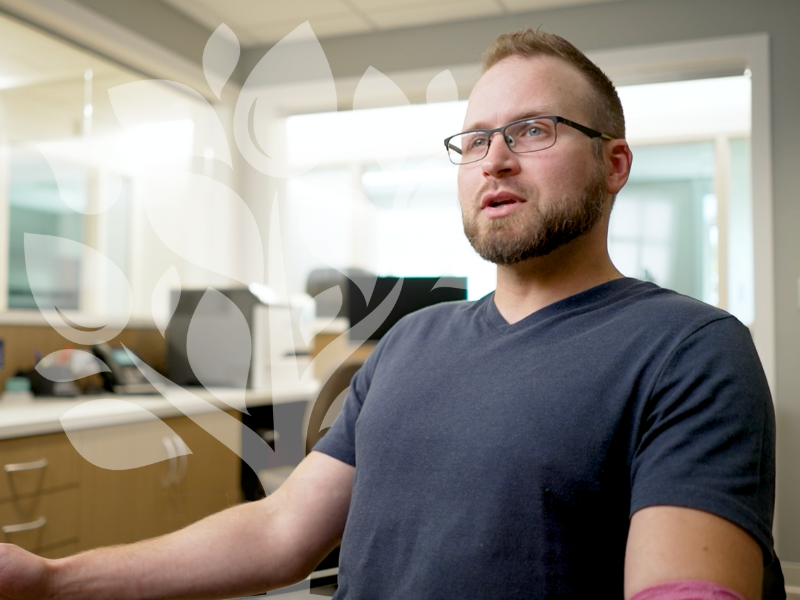Understanding the Importance of Physical Activity
Benefits of Exercise for Bleeding Disorders
Physical activity is essential for maintaining overall health, but it plays a particularly important role for individuals with bleeding disorders. Regular exercise helps to strengthen muscles, protect joints, and improve cardiovascular health, all of which can reduce the risk of bleeding episodes. It also contributes to mental well-being by reducing stress and enhancing mood. Explore our physical therapy services to learn more about how exercise can benefit you.
Risks of a Sedentary Lifestyle
A sedentary lifestyle can exacerbate the challenges associated with bleeding disorders. Lack of physical activity can lead to muscle weakness, joint stiffness, and weight gain, all of which increase the risk of bleeds and other complications. It’s important to find ways to stay active that are safe and enjoyable, helping to avoid these risks and improve your overall quality of life.
Choosing Safe Exercises
Low-Impact Exercises
Low-impact exercises are ideal for individuals with bleeding disorders because they minimize stress on the joints while still providing cardiovascular and muscular benefits. Some excellent options include:
- Walking: A simple, effective way to stay active that can be done almost anywhere.
- Swimming: Offers a full-body workout with minimal impact on the joints.
- Cycling: Helps build leg strength and endurance while reducing the risk of joint injuries.
These exercises can be easily adapted to your fitness level and are less likely to cause injuries.
Strength Training
Strength training is another valuable component of a fitness routine for those with bleeding disorders. It helps to build muscle strength, which can protect joints and reduce the risk of bleeds. However, it’s important to use proper techniques and start with lighter weights to avoid injury. Focus on exercises that target major muscle groups, and consider working with a physical therapist to ensure you’re following a safe routine.
Exercises to Avoid
High-Impact Sports
While staying active is important, certain activities should be avoided due to the high risk of injury. High-impact sports such as hockey, football, and rugby involve sudden movements and physical contact that can lead to joint bleeds and other injuries. It’s best to steer clear of these activities to minimize the risk of complications.
Activities with a High Risk of Injury
In addition to high-impact sports, activities that carry a high risk of falls or injuries, such as skiing, snowboarding, and martial arts, should also be avoided. These activities can put undue stress on your body and increase the likelihood of bleeds, particularly in the joints. Instead, opt for safer alternatives that still allow you to enjoy physical activity without the added risks.
Tailoring Exercise to Individual Needs
Consulting with Healthcare Providers
Before starting any new exercise regimen, it’s important to consult with your healthcare provider. They can assess your individual condition, recommend appropriate activities, and help you avoid exercises that might be harmful. Regular consultations can also help track your progress and make necessary adjustments to your exercise plan. Schedule a consultation with our primary care team to get started.
Creating a Personalized Exercise Plan
A personalized exercise plan is crucial for ensuring that your physical activity is both safe and effective. Your plan should take into account your specific bleeding disorder, your current bleeding disorder treatment plan, your current fitness level, and any other health conditions you may have. Working with a physical therapist or exercise specialist can help you develop a plan that meets your needs and goals. Learn more about creating a safe and effective exercise plan with our experts.
Managing Bleeding Risks During Exercise
Recognizing the Signs of a Bleed
During exercise, it’s important to be aware of the signs of a bleed so that you can take immediate action if necessary. Symptoms may include unusual pain, swelling, or stiffness in the joints, as well as bruising or bleeding that doesn’t stop. Recognizing these signs early can prevent further complications and ensure that you receive prompt treatment.
Immediate Actions to Take During a Bleed
If you suspect a bleed during exercise, stop the activity immediately. Apply pressure to the affected area if there is visible bleeding, and use ice to reduce swelling. It’s also important to rest the affected joint to prevent further damage. In more serious cases, seek medical attention right away.
Pre-Exercise Preparation
Warming Up
Warming up before exercise is crucial for preventing injuries, especially for those with bleeding disorders. A proper warm-up increases blood flow to the muscles, making them more flexible and less prone to injury. Start with gentle movements such as walking or slow cycling, gradually increasing intensity to prepare your body for more vigorous activity.
Importance of Stretching
Stretching after your warm-up helps to improve flexibility and reduce the risk of muscle strains. Focus on stretching all major muscle groups, holding each stretch for 15-30 seconds. Stretching is also a great way to cool down after exercise, helping to relax your muscles and prevent stiffness.
Post-Exercise Care
Cooling Down
Cooling down is just as important as warming up. It helps to gradually bring your heart rate and breathing back to normal, preventing dizziness and aiding in muscle recovery. A cool-down can include light aerobic activity, such as walking, followed by stretching to help relax the muscles.
Monitoring for Delayed Bleeds
After exercising, it’s important to monitor your body for any signs of delayed bleeds, particularly in the joints. Symptoms such as swelling, pain, or stiffness may not appear immediately, so it’s important to stay vigilant. If you notice any signs of a bleed, follow your emergency plan and seek medical attention if necessary.
Adaptive Sports and Activities
Introduction to Adaptive Sports
Adaptive sports are a great way for individuals with complications from their bleeding disorders to stay active in a safe and supportive environment. These sports are modified to accommodate different physical abilities, making them more accessible while minimizing the risk of injury. Examples of adaptive sports include wheelchair basketball, seated volleyball, and adapted swimming.
Popular Adaptive Sports for Bleeding Disorders
Participating in adaptive sports can provide numerous benefits, including improved physical fitness, social interaction, and enhanced self-esteem. Many communities offer programs specifically designed for individuals with bleeding disorders, allowing you to stay active and engaged in a safe setting.
Exercising with Joint Issues
Understanding Joint Health in Bleeding Disorders
Joint health is a major concern for individuals with bleeding disorders, as repeated bleeds can lead to joint damage over time. Maintaining strong muscles around the joints can help protect them and reduce the risk of bleeds. It’s important to choose exercises that are gentle on the joints and avoid activities that involve sudden or jarring movements. Our physical therapy services can help you develop a joint-friendly exercise routine.
Joint-Friendly Exercises
Certain exercises are particularly beneficial for joint health, including swimming, cycling, and yoga. These activities are low-impact and help to strengthen the muscles around the joints without putting excessive strain on them. Incorporating these exercises into your routine can help maintain joint flexibility and reduce the risk of bleeds.
The Role of Physical Therapy
Benefits of Physical Therapy
Physical therapy plays a crucial role in managing bleeding disorders, particularly when it comes to maintaining joint health and preventing bleeds. A physical therapist can create a personalized exercise plan that targets your specific needs, helping to strengthen muscles, improve flexibility, and reduce pain. Learn more about the benefits of physical therapy for bleeding disorders.
Incorporating Physical Therapy into Your Routine
Regular physical therapy sessions can help you stay on track with your exercise plan and make necessary adjustments as your condition changes. Your physical therapist can also provide guidance on safe exercises to do at home and help you develop strategies for managing pain and preventing injuries. Start incorporating physical therapy into your routine for better management of your bleeding disorder.
Staying Motivated
Setting Realistic Goals
Setting realistic and achievable goals is key to staying motivated with your exercise routine. Start with small, manageable goals and gradually increase the intensity and duration of your workouts as your fitness improves. Celebrate your progress along the way, and remember that consistency is more important than perfection.
Finding a Workout Buddy
Having a workout buddy can make exercise more enjoyable and help keep you accountable. Whether it’s a friend, family member, or support group member, having someone to share your fitness journey with can provide the encouragement and motivation you need to stick with your routine. Join a support group to connect with others who understand the challenges of living with a bleeding disorder.
Exercise for Children with Bleeding Disorders
Age-Appropriate Activities
It’s important to encourage children with bleeding disorders to stay active while ensuring that their activities are age-appropriate and safe. Low-impact activities such as swimming, cycling, and walking are excellent options for children. These activities help build strength and coordination without putting undue stress on their joints.
Encouraging Safe Play
Safe play is essential for children with bleeding disorders. Teach them about the importance of choosing safe activities and avoiding rough play or contact sports. Encourage open communication so they feel comfortable talking about their needs and limitations.
Balancing Exercise and Rest
Understanding the Importance of Rest
While exercise is important, it’s equally crucial to balance it with adequate rest. Overexertion can lead to fatigue and increase the risk of bleeds, particularly in the joints. Make sure to listen to your body and allow time for rest and recovery between workouts.
Signs You Need to Rest
Pay attention to signs that your body needs rest, such as persistent pain, fatigue, or swelling. Ignoring these signs can lead to injury and complications. Incorporating rest days into your exercise routine can help prevent overuse injuries and ensure that you’re giving your body the time it needs to recover.
Conclusion
Recap of Safe Exercise Practices
Staying active with a bleeding disorder requires careful planning and consideration, but the benefits far outweigh the challenges. By choosing low-impact exercises, avoiding high-risk activities, and incorporating physical therapy into your routine, you can improve your physical and mental well-being. Remember to consult with your healthcare provider before starting any new exercise regimen to ensure it’s safe for you.
Encouragement for Maintaining an Active Lifestyle
Living with a bleeding disorder doesn’t mean you have to give up on physical activity. With the right approach and support, you can lead a full, active life while managing your condition effectively. Stay motivated, set realistic goals, and don’t hesitate to seek support when needed. Contact our care team for personalized guidance on staying active with a bleeding disorder.




